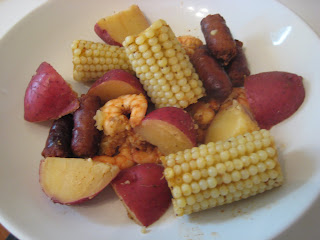One of my last meals before I went on holiday was shrimp boil. I saw this on an episode of Man vs Food and have wanted to make it ever since. My Mum gave me some corn on the cob from her garden and that meant that I definitely had to try it out. I have to say it was truly delicious and I am definitely going to make it again. The prawns were juicy and the spice from the old bay was incredible with the spicy merguez sausages and the flavours of the corn and potatoes.

Shrimp Boil
(Serves 2) (adapted from Cooking For Two by America's Test Kitchen)
1 tsp vegetable oil
4 merguez sausages, cut into 1 inch lengths
1 cup water
3 tsp old bay seasoning
2 garlic cloves, smashed
1 tsp tomato paste
1 bay leaf
1/2 lemon, halved
2 ears of fresh corn, husks and silks removed, cut into 2 inch rounds
8 oz red potatoes, halved if small, quartered if large
8 oz large shell-on prawns
1 tbsp minced fresh parsley or spring onions (optional)
Heat the oil in a medium saucepan over a medium-high heat. Add the sausage and cook until well browned, about 5 mins. Stir in the water, 2 tsp of the old bay seasoning, garlic, tomato paste, bay leaf, lemon, corn and potatoes and bring to the boil. Reduce the heat to medium low, cover and simmer until the potatoes are tender about 15-20mins.
In a medium bowl toss the prawns with the remaining old bay seasoning. Scatter the prawns in a single layer on top of the veg. Cover and continue to simmer until the bottoms of the prawns turn pink, about 1 min.
Flip the prawns, then remove the pan from the heat, cover and let sit until the prawns are just cooked through, about 2 mins. Strain the stew reserving the broth if desired, and discard the lemon, garlic cloves and bay leaf, sprinkle with the parsley or scallions if using.












